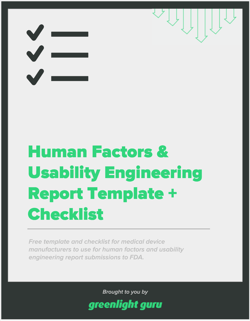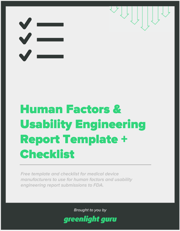Everything You Need to Know about Human Factors Engineering for Your Medical Device

Human factors are a key part of medical device development and the sooner they’re addressed in the development process, the better.
Understanding human factors engineering means minimizing the risk associated with your device and ensuring that usability is prioritized. If you can nail human factors, it’s an important step to creating a safe, effective device.
Human factors covers almost every aspect of your medical device. The main purpose is to ensure that your design, labeling, instructions and packaging promote safe and effective use of the device. Will the average user understand how to operate the device correctly?
Here is a quick and helpful guide to everything you need to know about human factors engineering for your medical device:
How Does FDA Define Human Factors Engineering (HFE) and Usability Engineering (UE)?
The terms “Human Factors Engineering” (HFE) and Usability Engineering (UE) are often used interchangeably. FDA’s definition of HFE is:
The application of knowledge about human behavior, abilities, limitations, and other characteristics of medical device users to the design of medical devices including mechanical- and software-driven user interfaces, systems, tasks, user documentation, and user training to enhance and demonstrate safe and effective use.
Human factors engineering and usability engineering can be considered to be synonymous.
As you can see, HFE has a lot to unpack. A key goal of engineering for all those areas of human factors is to reduce the use-related errors of devices. As much as we’d love to hope that all medical devices are safe and easy for users, a Johns Hopkins study has found that an estimated 15% of medical error deaths are related to medical device user interface difficulties or errors.
The term “user interface” (or UI for short) is an important one to understand in human factors. Where previously, a serious injury or death might have been attributed to “user error,” human factors uncovers why there might be human error in the first place.
The figure shown below represents the interactions between a user and a device, depicted in the purple zone as the user interface.
 Device User Interface in Operational Context (Redmill and Rajan, 1997)
Device User Interface in Operational Context (Redmill and Rajan, 1997)
The user interface (the part/s of the device, labeling, and more, that the user directly works with) is often an underlying cause. Maybe it is confusing or difficult to use. Perhaps instructions are unclear. In any case, instead of attributing blame automatically to the user, human factors looks at how the UI may have led to an error.
The Basics of Applying Human Factors and Usability Engineering to Medical Devices
At a very basic level, human factors come down to good design practice. It means keeping the end-user at the forefront of your product design and considering things like:
-
What relevant knowledge does the user have?
-
In what environment will the device be used?
-
What is the role of the user? Are they a patient, or are they a clinician assisting the patient?
-
What is the user demographic?
FDA provides guidance on human factors and implies the need for its application in 21 CFR 820:30. Human factors should be an early consideration of your design controls, including:
-
Clearly defining all end users of the device. Sometimes that involves a few different people, for example, you should include anyone who has to service or sterilize the device in a clinical setting.
-
Identifying the environment in which the device will be used.
-
Identifying user interfaces (every way they interact with the device) and critical tasks.
-
Identifying any known issues, perhaps with similar devices.
-
Conducting usability testing and from those results, making an effort to reduce any hazards with usability.
-
Conducting validation testing with human factors protocol included.
Human factors protocol should be part of your validation testing. FDA encourages you to submit a draft of your validation protocol for feedback, before conducting testing.
This is a good opportunity to take advantage of, if possible. It’s much better to get the early feedback on your validation testing and on how you are incorporating human factors, rather than find yourself needing to re-tool a device later.
One thing we are always conscious of is that a medical device shouldn’t be designed for just one person. Sometimes, in the excitement of producing a novel device, teams forge ahead and produce a device without conducting the necessary market research, only to find that it’s not viable or scalable in the market.
When designing your product, early considerations should include usability and market viability. This will improve your chances of gaining market share over competitors.
If you’re developing a device you’d like to sell in other markets, check out our Ultimate Guide to Bringing a Medical Device to Market.
How Do I Establish a Human Factors Design Process For Medical Devices?
One thing we reiterate here is that it’s never too early to create a human factors plan for your engineering process. In fact, accounting for human factors takes time and money, so it makes sense to plan early and avoid the possibility of having to backtrack.
It’s not just that having a human factors plan helps to ensure safety and efficacy, but that it also helps you to build a great user experience. Let’s face it, you’re a business and the better the experience you can deliver, the better for the marketability of your device and the reputation of your brand.
The basic components of any human factors design process can be broken down into three key areas:
- User research
- User evaluation
- User validation
Every human factors plan will look a bit different depending on your starting point, for example, whether you’re creating an entirely new device or modifying an existing device.
Some key points to address in your human factors plan during each research/testing phase include:
-
The physical product interface (e.g. how it physically works, where buttons are located etc.)
-
The software interface (if applicable). For example, is it easily understood? Does it operate how regular users might expect?
-
User manuals and quick guides. Do they cover all the pertinent information? Is it presented in a way that is easy to understand?
-
Labeling. Is it simple, legible and easy to follow?
-
Training. What training will be needed and what is the best format for delivery?
The outputs of your human factors engineering will form your Usability Engineering File, which FDA will review with your submission.
There are ten key outputs expected:
-
Use specification
-
User interface characteristics related to safety and potential use errors
-
Known or foreseeable hazards or hazardous situations
-
Hazardous-related use scenarios
-
Hazardous-related use scenarios for summative evaluation
-
User interface specification
-
User interface evaluation plan
-
Formative evaluation usability test reports
-
Summative evaluation test report
-
Usability engineering report
We suggest integrating your human factors process into your overall quality management plan early and keeping it a “living” plan. This helps to make it transparent to stakeholders in your company and ensure that it gets revised as-needed.
You can download our free template for Human Factors and Usability Engineering Reports that includes an interactive checklist.
Do I Need to Consider Human Factors For Medical Device Labeling?
In short, yes, absolutely. Labeling is as much part of the user interface as any other part of the device. This includes:
-
Instructions for use
-
User manual
-
Quick-start guide
-
Packaging
It’s important to note that in the FDA guidance, they favor addressing any use-related hazards by first adjusting the device design, rather than changing the labeling:
Addressing use-related hazards by modifying the device design is usually more effective than revising the labeling or training. In addition, labeling might not be accessible when needed and training depends on memory, which might not be accurate or complete.
Another important aspect of labeling from the FDA guidance is that you should include specific warnings on labeling related to “reasonably foreseeable” misuse. This includes describing the risk and potential consequences to “unintended but reasonably foreseeable users.” As an example, for home use devices, there is the potential that it will be within reach of children.
How should Human Factors Usability Testing be Incorporated in Product Development?
User research and evaluation are the best ways to ensure that usability testing is incorporated into each stage of product development. There are a few valid methods you can use for testing, so it’s important to evaluate your device and consider what sort of testing will net you the most useful information. For example:
-
User observation
-
Interviews (group or one-on-one)
-
Benchmark tests
In terms of human factors validation, both FDA and IEC 62366 guidelines have very useful rules to follow. For validation, FDA is a little more prescriptive than IEC, requiring manufacturers to conduct testing on at least fifteen US citizens and to do so in their natural environment.
If you’re unsure which validation activities you should use, you can always look for summaries of regulatory approval applications for similar products. These will often have a brief outline of the testing that was used. As stated earlier, you can also submit a draft plan to the FDA for feedback.
Human Factors Engineering is Essential for MARKETING High Quality Medical DeviceS
Human factors engineering is essential for bringing a high-quality medical device to market because, in the end, it’s about providing the best quality management solution for patients under actual conditions of use.
Ultimately, it is the patient for whom your medical device is intended to serve in the first place; human factors testing ensures that it is as safe and effective as possible.
Greenlight Guru’s QMS software is a purpose-built solution that helps medical device companies establish and maintain human factors documentation in compliance with the latest regulatory best practices from around the world. Get your free demo of our QMS software today.
Looking for a design control solution to help you bring safer medical devices to market faster with less risk? Click here to take a quick tour of Greenlight Guru's Medical Device QMS software
Tom Rish is a Medical Device Guru at Greenlight Guru who works with customers to utilize their QMS software to build safer products on expedited timelines. He is a Biomedical Engineer who began his career developing implant and instrument systems in the orthopedic industry. He enjoys helping customers successfully...
Related Posts
Medical Device 3D Printing: Should You Make the Move?
7 FDA Pathways to Bring Your Medical Device to Market
How to Demonstrate Substantial Equivalence in 5 Easy Steps
Get your free template
Human Factors & Usability Engineering Report Template + Checklist











